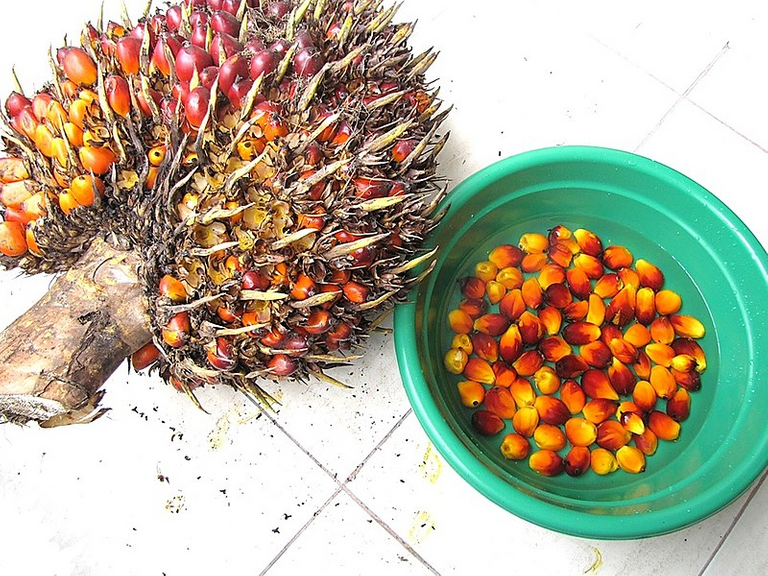Palm oil, also known as red oil, is a vegetable oil that is usually derived from the fruits of the oil palm tree, scientifically known as Elais guineensis. The oil palm tree is widely distributed within the tropics and genetically modified and cultivated in many countries of the world. In Nigeria, the oil palm tree can be found growing naturally within the rainforest regions transcending the Southwestern, Southsouth, SOutheast, and parts of the middle-belt regions of the country. Apart from palm oil, the oil palm tree has a wide variety of derivative products that are of immense importance to the people living in these regions and beyond.
The leaves of the tree are utilized in building construction, the tree itself is usually tapped for their saps which serve as a popular alcoholic drink known as palm wine, the endocarp is processed for its oil, and the remains utilized as palm kernel cake. One of the most surprising pieces of knowledge I recently gained is the utilization of the stem of the tree as timber for construction. A popular saying among the locals around actually points to the fact that every part of the oil palm tree is money, meaning that every part of the tree serves one or more purposes.
Palm oil in itself is widely consumed worldwide. The oil is edible and is included as an ingredient in the making of different recipes. The oil is made largely of fatty acids, glycerols, moisture, and unsaponifiable contents. It is extracted from the fruits of the oil palm tree. The fruits are usually held in a bunch and each fruit consists of 70 to 80% mesocarp with stony endocarp taking up the rest. The oil constitutes 45 to 50% of the mesocarp while the rest is made up mainly of fibers.
Apart from consumption, red oil is utilized in pharmaceutical and cosmetic products as well as other industrial uses.
The making of palm oil
A large percentage of palm oil being produced and consumed in Nigeria is manually processed. The chronological steps of producing palm oil locally as follows:
Harvesting of fruits
Matured fruits of the tree are manually harvested using a rope climber and a well-sharpened ax or cutlass. The harvesting person climbs the tree using the rope climber. On getting to the top of the trunk, he cuts down some of the leaves of the tree to expose the stalk of the fruit bunches before cutting the stalk itself to bring down the bunches. The force with which harvested bunches land on the ground displaces some of the fruits from the bunches and the displaced fruits are usually picked up by delegated labourers. For improved breeds of oil palm trees that are selected for their short height which makes harvesting easier, it is enough to just cut off a few of the fronds to expose the stalk holding the fruit bunch and cutting off the bunch without the need for climbing.

Harvested fruits are conveyed to the processing center where the bunches are subjected to further processing leading to the extraction of palm oil from the fruits.
Processing
At the processing center, harvested bunches of oil palm fruits are gathered and covered with palm fronds for a few days to allow for ripening and easier removal of fruits from bunches. Bunches are then vigorously shaken to remove the fruits. The fruits are then gathered into big metal drums. After adequate water is added to each drum, they are then heated for several hours (sometimes up to 12 hours) till the mesocarp of the fruits become very soft.
The boiled fruits are then transferred to a large wooden or ceramic basin, allowed to cool down, and then mashed together in order to separate the mesocarp from the endocarp. Locally, the mashing is done with legs. One or more individuals enter the basin and mash the fruits with their bare feet with a stick in either hand acting as supports.
After thorough mashing, the basin is filled with water and the content adequately agitated. This agitation causes the oil content of the mesocarp to start floating on the water. Floated oil is manually filtered and collected into a metal drum (or drums, depending on the volume). The content of the basin is further agitated and filtering/oil collection is repeated until virtually all the oil in the mesocarp has been drained.

Next is the heating of the filtrate. The collected oil is heated for several hours to improve the appearance and organoleptic property of the finished product. The cooked oil is then transferred to containers for marketing or storage.
Incredible, I did not know that the extraction was done manually, there must be big quantities of fruit. Approximately how many liters of oil are obtained per kilo of fruit?
I am not sure I know the exact mathematics but a big bunch of the fruit might not fetch more than 2 liters
Thanks for your contribution to the STEMsocial community. Feel free to join us on discord to get to know the rest of us!
Please consider supporting our funding proposal, approving our witness (@stem.witness) or delegating to the @stemsocial account (for some ROI).
Please consider using the STEMsocial app app and including @stemsocial as a beneficiary to get a stronger support.
One more time nature proofs how important is for a healthy living and that we know so little about it! Loving it!